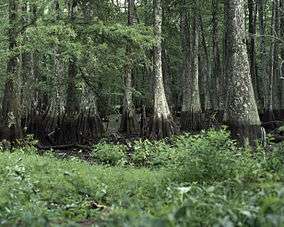Bayou Cocodrie National Wildlife Refuge
Bayou Cocodrie National Wildlife Refuge was established in 1992 to preserve waterfowl habitat and hardwood forest of the lower Mississippi river. The 13,200-acre (53 km2) refuge is located in Concordia Parish, Louisiana, 10 miles (16 km) southwest of Vidalia, Louisiana. It is named for the state-designated scenic river[1] of Bayou Cocodrie.
| Bayou Cocodrie National Wildlife Refuge | |
|---|---|
IUCN category IV (habitat/species management area) | |
 Bald cypress stand at Bayou Cocodrie. | |
| Location | Concordia Parish, Louisiana |
| Nearest city | Vidalia, Louisiana |
| Coordinates | 31°33′00″N 91°38′00″W |
| Area | 13,200 acres (53 km2) |
| Established | 1992 |
| Governing body | U.S. Fish and Wildlife Service |
| Website | Bayou Cocodrie National Wildlife Refuge |
The Nature Conservancy purchased an 11,403-acre (46.15 km2) core tract in 1991[2] from the Fisher Lumber Company, a subsidiary of General Motors Corporation. The Conservancy then sold the land to the US Fish and Wildlife Service over a span of five years.
The bottomland hardwoods at Bayou Cocodrie have been noted as some of the last remaining, least disturbed timber of what historically was once a vast hardwood forest along the Mississippi River from Illinois to Louisiana.[3]
Flora and fauna
The majority of the refuge is hardwood forest of oak, gum, and ash.[4] A 1,000-acre (4.0 km2) site of hardwood is designated a natural resource area for study purposes. The remaining habitat is wetlands utilized by wintering waterfowl such as mallard, pintail and shoveler duck species. The wood duck is found in the refuge and is one of the reasons for the establishment of the Bayou Cocodrie National Wildlife Refuge.[4] Other birds include bald eagle, peregrine falcon, osprey and Swainson's warbler. At least 186 bird species have been identified in the refuge.[5]
The Louisiana black bear, federally listed as threatened since 1992,[6] is known to occur in the Bayou Cocodrie. The historic range of the Louisiana black bear included southern Louisiana, Mississippi and east Texas, and is a subspecies of the American black bear.[7]
See also
- List of National Wildlife Refuges: Louisiana
Notes
- Natchez Democrat "Bayou may be cleared" by Vershal Hogan 2008
- "The Nature Conservancy, Louisiana preserves". Archived from the original on 2008-12-02. Retrieved 2010-05-27.
- Batou Cocodrie Final Conservation Plan, Ch 1 p.4
- Bayou Cocodrie pdf from Fish and Wildlife Service 1998
- Natchez Democrat "Bayou Cocodrie NWR outlines goals for next 15 years. 2004
- USFWS Species Profile
- Federal Register vol.57, no.4 Jan 27,1992 DOI Rules and Regulations.
References
![]()
External links
- Bayou Cocodrie National Wildlife Refuge - official site